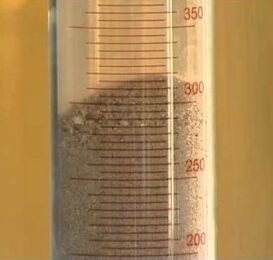Bulking of sand occurs when there is an increase in the amount of moisture that is present in the sand. To control the amount of sand that goes into each batch of concrete, it is necessary to conduct a bulking of the sand test. This article discusses the factors and principles of bulking of sand in detail.

Source: Pinterest
Bulking of sand: What is it?
The term “bulking of sand” refers to the process by which fine sand will experience an increase in volume when exposed to a certain level of moisture. The bulking effect will be seen to a greater degree the finer the sand is.
The following is an explanation of the bulking of sand:
- A thin layer of film is created around each individual grain of sand by the free moisture that is present in the sand.
- Because of the film’s surface tension, adjacent sand particles are prevented from getting too close to one another. This keeps the sand from clumping together.
- The water film is present on every particle, and this film is responsible for the surface tension that is experienced by other particles. Hence, the particles are kept away.
- This prevents the particles from coming into point contact with one another, as would have been the case otherwise.
- The term “bulking” refers to the process by which the volume of sand is increased despite the absence of contact between the particles.
Bulking of sand: Factors that influence
The following are four factors that have a significant impact on the bulking of sand:
Particle size
Sand that is dryer and of a finer grain size will have more air gaps surrounding the mineral particles than coarse sand would, which will cause it to bulk up more. Therefore, the bulking effect of sand is greatest for finer sand, and it gradually becomes less significant for coarser sand.
Form of the particles
The shape distribution of the particles determines how closely they will be packed together, which ultimately leads to an increase in bulk density. Bulk density is also determined by how the particles are distributed in the sand.
all about sand calculator
Pores in sand
It is dependent on the amount of pore space that is available in the soil. Because bulk density is dependent on the combined volume of solid and pore space, soil with a greater porosity will have a lower bulk density than soil with lower porosity.
Moisture content
When there is a higher percentage of moisture present, the volume of the sand will likewise rise. After reaching its highest point, however, which is when the moisture content reaches 25–40% at a level of 4-6%, it then begins to decrease gradually.
Bulking of sand: Principle
The accuracy of a sand test is dependent on the fact that the volume of sand when it is dry and when it is soaked has a volume that is very close to being the same.
Therefore, in this experiment, a container is filled with sand, and then water is put into it until it reaches the point where it is saturated. The volume of the sand decreases as it becomes saturated with water, revealing either the true volume of the sand or the volume of the sand when it is dry.
We can determine the value of bulking sand by calculating the difference in volume that exists between the volume of sand and the volume of sand after it has been soaked.
Bulking of sand: Test procedure
The following test methodology can be performed to determine the percentage of bulking that is present in the sand.
- Take the sand sample and fill the measuring cylinder to the 200 mm mark.
- Use the steel rule to make the appropriate modification, but do not compress the sand.
- The next step is to remove the sand from the container. During this period of transition, extreme caution should be used to ensure that the container has no traces of sand from the previous phase.
- Add 100 ml water to the same container.
- Add the sand to the container that is now full of water, and then use a rod to mix the sand in the container.
- Allow it to settle.
- The correct test will show sand below 200ml.
- When calculating the bulking of sand, use the formula: = (200-160)/160 = 40/160 = 1/4 (or 25%).
Bulking of sand: Significance
People often say that sand bulking is nothing more than the looseness of soil that has not been compacted, which is a straightforward explanation. In general, the presence of water in any sand causes the pores in the sand to shrink and causes the sand to become dense.
Sand is added to concrete to lessen the amount of segregation that occurs and to fill in the spaces that are left between the cement and the coarse aggregates. For instance, we’d want there to be a one-metre cube of sand in the concrete; thus, we’d like to have a general idea of the sand’s bulkage value. If the supplied sample has a bulkage of 25%, then we would want to demand 25% more sand or 1.25 times the sand, while volume batching compels 1 ㎥ of sand for concrete. This would bring the total amount of sand required to 1.25 times the original amount.
Bulking of sand: Percentage of bulking concerning volume
According to the standard IS2386-3 for bulking in the sand, the presence of 4% of moisture content causes a 25% increase in the volume of the sand.
| % of Moisture Content | % of Bulking WRT Volume |
| 2% | 15% |
| 3% | 20% |
| 4 % | 25% |
| 5 % | 30% |
see also about: M Sand
Bulking of sand: Limitations
- A concrete mixture that has been improperly bulked with sand might end up being more abrasive and difficult to work with.
- The production of concrete might suffer if the bulking of sand is not regulated properly.
- It has the potential to change the ratio of water to cement in concrete.
- If the standard concrete mix proportions are not met, the strength and durability of the concrete will be negatively impacted.
FAQs
Why is a bulk sand test required?
Bulking of sand tests is important to regulate the quantity of sand used in a given batch of concrete.
What consequences does sand bulking have on a construction site?
An overabundance of moisture in the sand causes the concrete to weaken and crumble.
What is sand's maximum bulking?
The level of sand bulking depends on the moisture content and fineness of the sand, with typical sand bulking ranging from 15 to 30 per cent. It rises with increasing moisture content until a specific threshold ((56%),5%) when it reaches its maximum.
How is the density of sand tested in the lab?
Researchers compute the bulking of sand value by measuring the difference between the volume of sand and the volume of sand when soaked.
Housing News Desk is the news desk of leading online real estate portal, Housing.com. Housing News Desk focuses on a variety of topics such as real estate laws, taxes, current news, property trends, home loans, rentals, décor, green homes, home improvement, etc. The main objective of the news desk, is to cover the real estate sector from the perspective of providing information that is useful to the end-user.
Facebook: https://www.facebook.com/housing.com/
Twitter: https://twitter.com/Housing
Email: [email protected]











